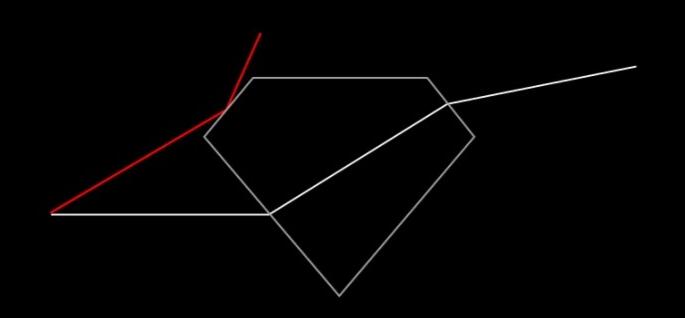在本教程中,您将学习如何使用Three.js在三个步骤中使对象看起来像玻璃。
渲染3D对象时,无论使用某种3D软件还是使用WebGL进行实时显示,始终都必须为其分配材料以使其可见并具有所需的外观。
可以使用Three.js之类的库中的现成程序来模仿许多类型的材料,但是在本教程中,我将向您展示如何使用三个对象(三个步骤)使对象看起来像玻璃一样。
步骤1:设定和正面折射
在本演示中,我将使用菱形几何图形,但是您可以跟随一个简单的盒子或任何其他几何图形。
让我们建立我们的项目。我们需要一个渲染器,一个场景,一个透视相机和我们的几何图形。为了渲染我们的几何图形,我们需要为其分配材质。创建此材料将是本教程的主要重点。因此,继续创建具有基本顶点和片段着色器的新ShaderMaterial。
与您期望的相反,我们的材料将不是透明的,实际上,我们将对钻石后面的任何东西进行采样和变形。为此,我们需要将场景(没有菱形)渲染为纹理。我只是使用正交摄影机渲染全屏平面,但这也可能是充满其他对象的场景。在Three.js中从菱形分割背景几何图形的最简单方法是使用“图层”。
this.orthoCamera = new THREE.OrthographicCamera( width / - 2,width / 2, height / 2, height / - 2, 1, 1000 );
// assign the camera to layer 1 (layer 0 is default)
this.orthoCamera.layers.set(1);
const tex = await loadTexture('texture.jpg');
this.quad = new THREE.Mesh(new THREE.PlaneBufferGeometry(), new THREE.MeshBasicMaterial({map: tex}));
this.quad.scale.set(width, height, 1);
// also move the plane to layer 1
this.quad.layers.set(1);
this.scene.add(this.quad);我们的渲染循环如下所示:
this.envFBO = new THREE.WebGLRenderTarget(width, height);
this.renderer.autoClear = false;
render() {
requestAnimationFrame( this.render );
this.renderer.clear();
// render background to fbo
this.renderer.setRenderTarget(this.envFbo);
this.renderer.render( this.scene, this.orthoCamera );
// render background to screen
this.renderer.setRenderTarget(null);
this.renderer.render( this.scene, this.orthoCamera );
this.renderer.clearDepth();
// render geometry to screen
this.renderer.render( this.scene, this.camera );
};好吧,现在该花一点点理论了。透明材料(如玻璃)可以弯曲,因此可见。那是因为光在玻璃中的传播要比空气中的传播慢,因此当光波以一定角度撞击玻璃物体时,这种速度变化会导致光波改变方向。波浪方向的这种变化描述了折射现象。

为了在代码中复制这一点,我们将需要知道我们的眼睛向量与世界空间中钻石表面(法线)向量之间的角度。让我们更新顶点着色器以计算这些向量。
varying vec3 eyeVector;
varying vec3 worldNormal;
void main() {
vec4 worldPosition = modelMatrix * vec4( position, 1.0);
eyeVector = normalize(worldPos.xyz - cameraPosition);
worldNormal = normalize( modelViewMatrix * vec4(normal, 0.0)).xyz;
gl_Position = projectionMatrix * modelViewMatrix * vec4(position, 1.0);
}在片段着色器中,我们现在可以将eyeVector和worldNormal用作glsl内置折射函数的前两个参数。第三个参数是折射率的比率,即我们的快速介质(空气)的折射率(IOR)除以我们的慢速介质(玻璃)的IOR。在这种情况下,该值为1.0 / 1.5,但是您可以调整该值以获得所需的结果。例如,水的IOR为1.33,钻石的IOR为2.42。
uniform sampler2D envMap;
uniform vec2 resolution;
varying vec3 worldNormal;
varying vec3 viewDirection;
void main() {
// get screen coordinates
vec2 uv = gl_FragCoord.xy / resolution;
vec3 normal = worldNormal;
// calculate refraction and add to the screen coordinates
vec3 refracted = refract(eyeVector, normal, 1.0/ior);
uv += refracted.xy;
// sample the background texture
vec4 tex = texture2D(envMap, uv);
vec4 output = tex;
gl_FragColor = vec4(output.rgb, 1.0);
}

真好!我们成功编写了折射着色器。但是我们的钻石几乎看不见……部分原因是我们只处理了玻璃的一种视觉特性。并非所有的光都会穿过要折射的材料,实际上,一部分光会被反射。让我们看看如何实现它!
步骤2:反射和菲涅耳方程
为了简单起见,在本教程中,我们将不计算适当的反射,而仅将白色用作反射光。现在,我们怎么知道什么时候该反思,什么时候该折射?理论上,这取决于材料的折射率,当入射矢量和表面法线之间的角度大于临界角时,光波将被反射。

在片段着色器中,我们将使用菲涅耳方程来计算反射光线与折射光线之间的比率。不幸的是,glsl也没有内置此方程式,但是您可以从这里复制它:
float Fresnel(vec3 eyeVector, vec3 worldNormal) {
return pow( 1.0 + dot( eyeVector, worldNormal), 3.0 );
}现在,我们可以根据刚计算出的菲涅耳比,简单地将折射纹理颜色与白色反射颜色混合。
uniform sampler2D envMap;
uniform vec2 resolution;
varying vec3 worldNormal;
varying vec3 viewDirection;
float Fresnel(vec3 eyeVector, vec3 worldNormal) {
return pow( 1.0 + dot( eyeVector, worldNormal), 3.0 );
}
void main() {
// get screen coordinates
vec2 uv = gl_FragCoord.xy / resolution;
vec3 normal = worldNormal;
// calculate refraction and add to the screen coordinates
vec3 refracted = refract(eyeVector, normal, 1.0/ior);
uv += refracted.xy;
// sample the background texture
vec4 tex = texture2D(envMap, uv);
vec4 output = tex;
// calculate the Fresnel ratio
float f = Fresnel(eyeVector, normal);
// mix the refraction color and reflection color
output.rgb = mix(output.rgb, vec3(1.0), f);
gl_FragColor = vec4(output.rgb, 1.0);
}
看起来已经好多了,但是还有一些不足之处……嗯,我们看不到透明对象的另一面。让我们解决这个问题!
资源搜索网站大全 https://www.renrenfan.com.cn 广州VI设计公司https://www.houdianzi.com
步骤3:多边折射
到目前为止,我们已经了解了有关反射和折射的知识,我们可以理解,光在离开对象之前可以在对象内部来回反弹几次。
为了获得物理上正确的结果,我们将必须跟踪每条光线,但是不幸的是,这种计算量太大,无法实时渲染。因此,我将向您展示一个简单的近似值,至少可以直观地看到我们钻石的背面。
在一个片段着色器中,我们需要几何图形的正面和背面的世界法线。由于我们不能同时渲染两侧,因此需要首先将背面法线渲染为纹理。

让我们像在步骤1中一样制作一个新的ShaderMaterial,但是这次我们将世界法线渲染为gl_FragColor。
varying vec3 worldNormal;
void main() {
gl_FragColor = vec4(worldNormal, 1.0);
}接下来,我们将更新渲染循环以包括背面通道。
this.backfaceFbo = new THREE.WebGLRenderTarget(width, height);
...
render() {
requestAnimationFrame( this.render );
this.renderer.clear();
// render background to fbo
this.renderer.setRenderTarget(this.envFbo);
this.renderer.render( this.scene, this.orthoCamera );
// render diamond back faces to fbo
this.mesh.material = this.backfaceMaterial;
this.renderer.setRenderTarget(this.backfaceFbo);
this.renderer.clearDepth();
this.renderer.render( this.scene, this.camera );
// render background to screen
this.renderer.setRenderTarget(null);
this.renderer.render( this.scene, this.orthoCamera );
this.renderer.clearDepth();
// render diamond with refraction material to screen
this.mesh.material = this.refractionMaterial;
this.renderer.render( this.scene, this.camera );
};现在,我们在折射材料中采样背面法线纹理。
vec3 backfaceNormal = texture2D(backfaceMap, uv).rgb;最后,我们结合了正面和背面法线。
float a = 0.33;
vec3 normal = worldNormal * (1.0 - a) - backfaceNormal * a;在此等式中,a只是一个标量值,指示应应用背面法线的数量。

我们做到了!我们可以看到钻石的所有侧面,仅是因为我们对钻石的材质进行了折射和反射。
局限性
正如我已经解释的那样,用这种方法实时渲染物理上正确的透明材料是不可能的。当在彼此前面渲染多个玻璃对象时会发生另一个问题。由于我们仅对环境采样一次,因此无法看透一连串的对象。最后,我在这里演示的屏幕空间折射在画布的边缘附近效果不佳,因为光线可能会折射到其边界之外的值,并且在将背景场景渲染到渲染目标时我们没有捕获到该数据。
当然,有多种方法可以克服这些限制,但是对于您在WebGL中进行实时渲染,它们可能并不是全部很好的解决方案。